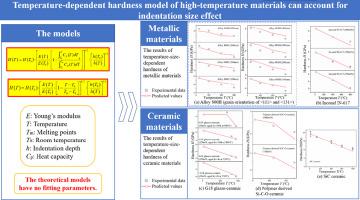International Journal of Refractory Metals & Hard Materials ( IF 4.2 ) Pub Date : 2022-07-29 , DOI: 10.1016/j.ijrmhm.2022.105957 Yumeng Liu , Ruzhuan Wang , Yu Wan , Shan Zhou , Hongwei Cai , Mingyu Gu , Dingyu Li , Weiguo Li

|
Indentation size effect has been found in the micro-nano hardness tests of both ceramic materials and metallic materials, even at high temperature. However, there are few temperature-dependent hardness theoretical models that can quantitatively characterize the indentation size effect of materials. This work introduces the indentation size effect into a novel temperature-dependent hardness model of materials by using energy method. The model takes into account the Young's modulus, indentation depth, melting point, and constant pressure heat capacity of materials without any fitting parameters. Further, for solving the problem of the difficulty to obtain the heat capacity of some materials, a simpler temperature-dependent model that just includes the Young's modulus, indentation depth and melting point is proposed. The remarkably excellent agreements between predicted and measured data of both ceramic materials and metallic materials verify the currency of the models. In addition, the effects of indentation depth and Young's modulus on the hardness of materials and their evolution with temperature are studied.
中文翻译:

高温材料的温度相关硬度模型可以解释压痕尺寸效应
在陶瓷材料和金属材料的微纳硬度测试中都发现了压痕尺寸效应,即使在高温下也是如此。然而,很少有温度相关的硬度理论模型可以定量表征材料的压痕尺寸效应。这项工作利用能量法将压痕尺寸效应引入到一种新的材料温度相关硬度模型中。该模型考虑了材料的杨氏模量、压痕深度、熔点和恒压热容,没有任何拟合参数。此外,针对某些材料的热容难以获得的问题,提出了一种仅包含杨氏模量、压痕深度和熔点的更简单的温度相关模型。陶瓷材料和金属材料的预测和测量数据之间非常出色的一致性验证了模型的通用性。此外,还研究了压痕深度和杨氏模量对材料硬度的影响及其随温度的演变。











































 京公网安备 11010802027423号
京公网安备 11010802027423号